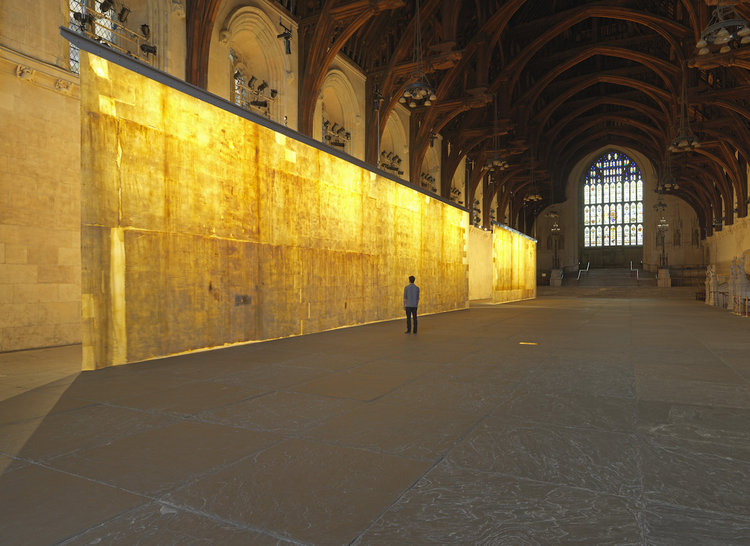Writing
The Ethics of Dust
Jorge Otero-Pailos - The time is now exhibition - Millennium Gallery, Sheffield
Two huge sheets of latex suspended from the gallery ceiling form a translucent wall which divides the exhibition in two. Upon closer inspection, one feels engulfed by its enormity, gazing in front and above, spotting a bumpy residue forming smalls hills and crevices across the whole surface of it. Obstructing the space, visitors are forced to walk around the delicate fragile wall. Many notice and appreciate it’s minimalist form, but neglect the opportunity to read the supporting plaque, bypassing the gravity of the piece.
The Ethics of Dust, originally commissioned by Artangel was created by artist and architectural preservationist Jorge Otero-Pailos in 2016. Originally the piece was over 50 meters long, it is the original cast of walls from the UNESCO world heritage site, Westminster Hall in London. The latex was sprayed onto the walls, then peeled off, gently lifting dirt from the surface. These latex forms were then suspended in Westminster Hall and illuminated by a mix of natural light and a subtle warmer amber light. The original piece was divided and acquired by museums across the country. Visitors to the show in Sheffield, view a segment of it, which is now part of the museum’s permanent collection.
The Ethics of Dust, originally commissioned by Artangel was created by artist and architectural preservationist Jorge Otero-Pailos in 2016. Originally the piece was over 50 meters long, it is the original cast of walls from the UNESCO world heritage site, Westminster Hall in London. The latex was sprayed onto the walls, then peeled off, gently lifting dirt from the surface. These latex forms were then suspended in Westminster Hall and illuminated by a mix of natural light and a subtle warmer amber light. The original piece was divided and acquired by museums across the country. Visitors to the show in Sheffield, view a segment of it, which is now part of the museum’s permanent collection.

Image: Jorge Otero-Pailos - The Ethics of Dust, 2016, Westminster Abbey. Marcus J Leith©
The acquisition of this piece is an apt investment for Sheffield Museums. The title for the piece, ‘The Ethics of Dust’, was inspired by John Ruskin’s book, who had a great admiration for gothic Westminster, he was also a huge benefactor to the city of Sheffield and founded The Ruskin Collection which is part of Sheffield Museums. When alive, he had concerns over pollution, recognising its damaging effects on buildings but argued against surface cleaning Westminster due to potential damage. These days, conservation technology has now advanced to the point where cleaning can be safely and sensitively carried out without damaging the stone, and how appropriate to house this artefact in a collection and institution in Sheffield which Ruskin part founded himself. He opened a guild which founded the museum specifically for Sheffield’s workers, and would surely be delighted to see this historical archival momenutal piece of England’s history available to be viewed for free, by the whole community of Sheffield.
The latex walls contain hundreds of years of surface pollution, dust held captive in translucent latex. Otero-Pailos raises awareness and encourages a deeper reflection on one of humanity’s most neglected, and also most prolific cultural products: pollution/dust. He is interested in why we take care of things, and explores whether by cleaning something, we lose something from it. As a thing grows, it decays, the fabric of reality is woven with impermanence. So why do we want to preserve, conserve and hold onto objects?
Lastly, the piece unquestionably points to the history of UK politics. One examines the particles which have been collected on the limestone walls since 1099, and thinks about the dust, soot and dirt generated during historical events. The Second World War Blitz, the Great Smog of 1952, and the trail of Guy Fawkes in 1606. Being 31 myself, I was taught these histories at school, as they shaped the country and in a way, my own identity and privilege. Reimagining everyday life back then was impossible, but instead, I contemplated the year 2016 when the piece was made. This was also the year that the Brexit vote took place. I remember how different the British political climate was just a short time ago. Now unrecognisable, in the midst of Brexit chaos, I am witness to living in a newly politicised era, and watch how our outdated state apparatus’ polarise the country. We watch in disbelief, and wait for the dust to settle.
The latex walls contain hundreds of years of surface pollution, dust held captive in translucent latex. Otero-Pailos raises awareness and encourages a deeper reflection on one of humanity’s most neglected, and also most prolific cultural products: pollution/dust. He is interested in why we take care of things, and explores whether by cleaning something, we lose something from it. As a thing grows, it decays, the fabric of reality is woven with impermanence. So why do we want to preserve, conserve and hold onto objects?
Lastly, the piece unquestionably points to the history of UK politics. One examines the particles which have been collected on the limestone walls since 1099, and thinks about the dust, soot and dirt generated during historical events. The Second World War Blitz, the Great Smog of 1952, and the trail of Guy Fawkes in 1606. Being 31 myself, I was taught these histories at school, as they shaped the country and in a way, my own identity and privilege. Reimagining everyday life back then was impossible, but instead, I contemplated the year 2016 when the piece was made. This was also the year that the Brexit vote took place. I remember how different the British political climate was just a short time ago. Now unrecognisable, in the midst of Brexit chaos, I am witness to living in a newly politicised era, and watch how our outdated state apparatus’ polarise the country. We watch in disbelief, and wait for the dust to settle.
